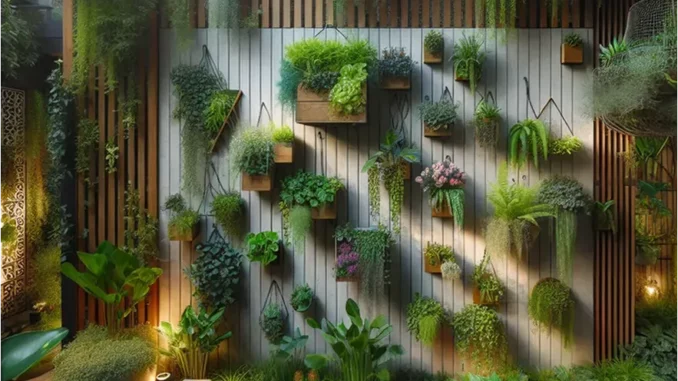
Transforming Small Spaces: Expert Tips for Exceptional Garden Design
Gardens, regardless of their dimensions, possess the unique ability to metamorphose outdoor areas into enchanting and functional retreats. Small gardens, in particular, offer a canvas ripe for creativity and innovation. With meticulous design and strategic planning, even the most modest spaces can be transformed into lush, vibrant oases. Here, we delve into expert-recommended garden design ideas tailored for small spaces, including vertical gardening, multifunctional areas, and more.
1. Vertical Gardening: Elevating Your Green Space
Vertical gardening is a revolutionary approach for compact spaces, enabling you to capitalise on vertical real estate by cultivating plants upwards. This technique not only conserves ground space but also introduces visual intrigue and can enhance air quality.
Expert Insight: “Vertical gardening is ideal for small gardens as it maximises space and adds a new dimension to the landscape,” advises garden designer Sarah Williams.
To incorporate vertical gardening, consider wall-mounted planters, trellises, and hanging baskets. Repurposing items like wooden pallets or old ladders can also create unique vertical structures. Opt for climbing vines, trailing plants, and compact shrubs that thrive in vertical environments, and be mindful of their light and water needs.
2. Container Gardening: Versatile and Portable Solutions
Container gardening offers unparalleled flexibility and portability, perfect for patios, balconies, or windowsills in urban settings.
Design Tip: Choose containers that match the scale of your plants and ensure they have proper drainage. Terra cotta pots, wooden planters, and ceramic containers are popular, but lightweight alternatives like plastic or fibreglass facilitate easier movement.
Create visually appealing arrangements by mixing colours, textures, and heights. For instance, pair tall ornamental grasses with medium-height flowers and trailing plants to introduce depth and dimension.
3. Multifunctional Spaces: Optimising Every Inch
In small gardens, every square foot counts. Designing multifunctional spaces that serve various purposes is crucial.
Pro Advice: Incorporate built-in seating with storage to save space and maintain organisation. Foldable or stackable furniture can also be invaluable, offering practicality without compromising on style.
4. Creating Focal Points: Enhancing Visual Appeal
Focal points are pivotal in garden design, drawing the eye and creating depth and interest.
Consider a statement piece, such as a sculpture, water feature, or large potted plant, as the garden’s centrepiece. Surround it with complementary plants and design elements to craft a cohesive and captivating arrangement.
5. Using Mirrors: Expanding Perceived Space
Mirrors can ingeniously make small gardens appear more spacious by reflecting light and creating the illusion of depth.
Implementation: Select outdoor-friendly materials and secure the mirrors properly. Frame them with plants or decorative elements to seamlessly integrate them into the garden design.
6. Incorporating Water Features: Infusing Tranquillity
Water features, like small fountains, birdbaths, or bubble fountains, can instil a sense of tranquillity and movement in small gardens. The sound of flowing water fosters a calming atmosphere, transforming your garden into a serene retreat.
Choose a water feature that complements your garden’s design and ensure it is easily accessible for maintenance.
7. Edible Gardens: Cultivating Your Own Produce
Growing your own fruits, vegetables, and herbs is feasible even in limited spaces, providing fresh produce and enhancing your garden’s beauty and fragrance.
Plant Selection: Use raised beds, container gardens, or vertical gardening techniques. Herbs like basil, mint, and rosemary thrive in containers and can be grown on patios or windowsills. Compact vegetables such as cherry tomatoes, peppers, and lettuce are ideal for small raised beds or containers.
8. Lighting: Crafting Ambiance and Functionality
Proper lighting is indispensable in small gardens, enhancing both ambiance and functionality.
Lighting Options: Ambient lights, such as string lights, lanterns, and solar-powered garden lights, add warmth. For task lighting, pathway lights or spotlights illuminate walkways and seating areas. Accent lighting, like uplighting for trees or decorative fixtures, highlights focal points and adds visual interest.
9. Colour and Texture: Enriching Visual Interest
In small gardens, the judicious use of colour and texture is key to generating visual interest and depth.
Design Strategy: Select a colour palette that aligns with your home and personal style. Combine smooth-leaved plants with those possessing fuzzy or textured foliage. Incorporate a mix of flowering plants and evergreens to ensure year-round appeal. Brightly coloured pots, garden art, and outdoor cushions can provide vibrant pops of colour.
10. Personal Touches: Infusing Your Unique Style
Infusing personal touches into your small garden makes it uniquely yours.
Consider handmade garden art, distinctive planters, or family heirlooms. Create a cosy seating area with comfortable cushions and throws, or add an outdoor rug to define the space. These personal elements not only enhance your garden’s charm but also cultivate a sense of ownership and pride.
By embracing these expert tips and incorporating thoughtful design elements, you can transform even the smallest of gardens into a lush, vibrant oasis that reflects your personality and style. Whether cultivating your own produce, creating a tranquil retreat, or designing a visually stunning space, the key lies in meticulous planning and a touch of personal flair.


Be the first to comment